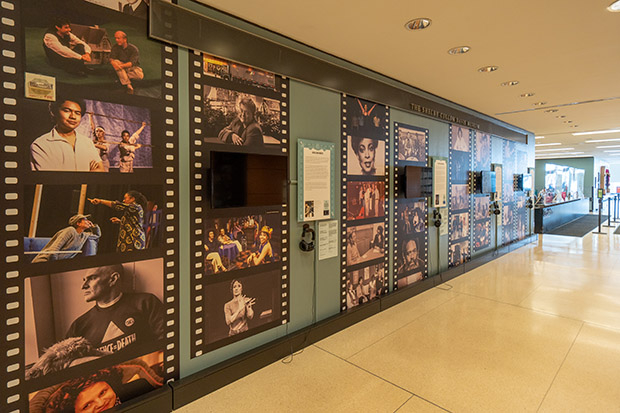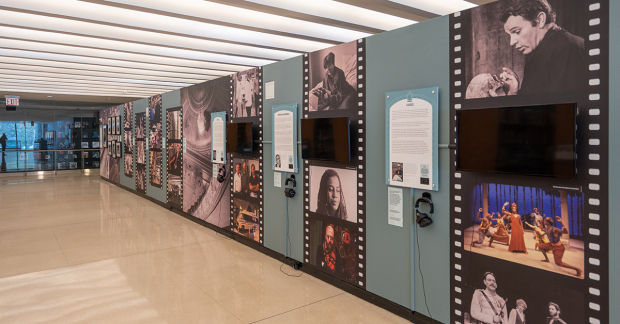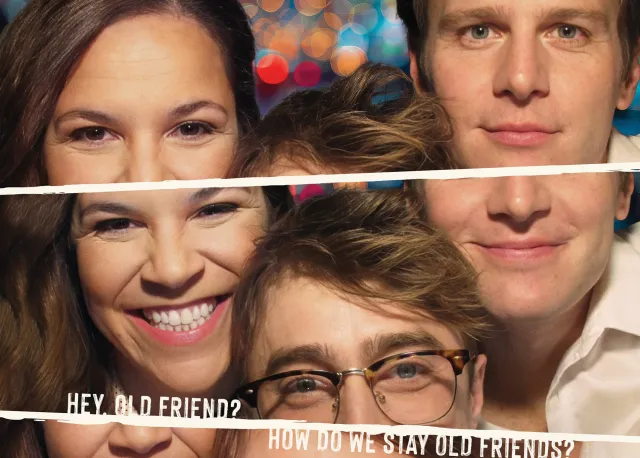Celebrating 50 Years of the Theatre on Film and Tape Archive at the New York Public Library
Curator Patrick Hoffman takes us inside a new exhibit to mark the collection’s landmark anniversary.
The past half-century of theater history is on display as part of the ongoing exhibition Focus Center Stage: 50 Years of the Theatre on Film and Tape Archive at the New York Public Library for the Performing Arts at Lincoln Center.
Scaling two floors of the library's corridor gallery, the exhibit, which opened in July and is scheduled to run until February 25, showcases excerpts from dozens of the productions that the archive has filmed, as well as behind-the-scenes photographs, interviews, and more. At the helm is Patrick Hoffman, who has served as curator of the Theatre on Film and Tape archive since 2001, and was assistant curator to founder Betty Corwin prior to that. Here, Hoffman tells us a little bit about what it takes to get a show filmed for posterity, and putting together this massive collection, which is on display to the public for free.

(image provided by the New York Public Library for the Performing Arts)
This conversation has been condensed and edited for clarity.
Let's start from the beginning. What goes into any show getting taped for the archive?
It's a lot of work. We have to work with the producers, the company manager, and the general management about establishing a tape date, so they can provide us with seats for camera locations. I have to secure permissions from all of the creatives involved: playwright, composer, lyricist, book writer, director, choreographer, scenic designer, costume designer, the animal trainer, if there are any live animals in the show, and, of course, every actor in the show has to agree to the taping in order for it to move forward.
I'm also hiring the video crew: the truck, the director, the assistant director, technical director, sound engineer, all the camera operators and video engineers, and I have to make arrangements for them to see the show in advance so they can take their notes and do pre-production. All of that happens before the curtain even goes up. This past year, with Covid, has been a nail biter because you never knew if somebody could go down. We have been unbelievably lucky, because we did not have to cancel a single recording last season.
Who decides what gets taped?
Part of what I do in my role is going out and seeing productions and making those sometimes very tough curatorial decisions as to what we want to preserve and what we might have to pass by. Unfortunately, it's pretty expensive, so we can't afford to tape every show. Sometimes, producers approach us and campaign for us to tape the shows, and sometimes, if a producer can afford it, they'll make a donation to help us out. We love when that can happen.
We generally record around 50 productions per year. As a general rule of thumb, and this has been true for our entire 52-year history, we have taped more off-Broadway every season than Broadway. It's where the most interesting, innovative, exciting work is happening. Often, we're documenting off-Broadway shows before they move. We taped In the Heights off-Broadway and later went to tape it on Broadway. We taped Rent at New York Theatre Workshop. I approached The Band's Visit and Kimberly Akimbo about taping them at the Atlantic and their producers asked to wait for the Broadway version because they were still planning changes and they'd rather have them preserved in the completely finished state.
The question during the pandemic, of course, was "Why can't you put this stuff online?" So once and for all, why can't you put these videos online?
Well, we operate because we have contracts with all of the theatrical unions and guilds, and they do not allow us to stream our videos. They have to be watched on site here at Lincoln Center. We have had conversation around that, even during the pandemic. We had a couple of proposals out to them, but not everyone was agreeable to it. They really want to keep it the way it is.
Streaming is also a new source of revenue and income for a lot of their members. When something is streamed, a costume designer or a director is being paid for that. The other thing is that we are a nonprofit and we exist to preserve things for theater history, to provide research and access to theater professionals, scholars, students, journalists, performers. The streaming services that have risen up over the last few years are really for-profit entities, so when the unions and guilds are approached about taping for those purposes, everyone involved is getting paid. And that's really the difference, and why the for-profit entities can't do as many things as we do.

(image provided by the New York Public Library for the Performing Arts)
Can you talk about the logistics of the exhibit?
We started on it in early 2019, hoping to open it in the autumn of 2020, which would've been our actual 50th anniversary. Obviously, global pandemic. I worked on it from home most of that summer, having to curate it out of my head because they wouldn't allow us in the building, and we couldn't come and look at any video footage. I was using the online card catalog to think about what might be good for the show, and wrestling with how we were going to approach it, because there were so many different ways. We could have built it around actors, directors, choreographers, or designers, but theater is a collaborative art form. Ultimately, I came back to William Shakespeare and said, "The play's the thing." That's what we built it around. This is a repository of an art form that doesn't exist past closing date.
What are some of the plays and musicals that people are able to watch footage of when they explore the exhibition?
There's a clip of TOFT's very first recording, which was an avant-garde, off-Broadway, Japanese rock musical called Golden Bat, which has an all-Asian cast. We have Meryl Streep in The Seagull in Central Park with Kevin Kline, Philip Seymour Hoffman, Christopher Walken, and Natalie Portman. We have David Carroll and Jane Krakowski in the workshop of Grand Hotel. Donna Murphy in Anyone Can Whistle for Encores!, and she completely knocks it out of the park. We have a clip of both Cynthia Nixon and Laura Linney swapping roles in The Little Foxes, Bette Midler and Carol Channing in Hello, Dolly! It goes on and on and on.
What are you most proud of in seeing all this history come together?
It comes back to our original mission, which is to preserve things for theater history. Betty Corwin, part of her impetus for founding the archive, was that she had seen Laurette Taylor in The Glass Menagerie and thought that it was a shame that once the curtain fell, there was no moving-image record of these productions. Still photos exist, but they don't show you how the actors moved, or what the choreography was like.
I think it's that. And the incredible diversity in the collection, in every sense of the word: we have Shakespeare and Shaw and O'Neill and Mamet and McDonough and Vogel. Throughout our entire history, we habe documented productions from Black and Latin and Asian and LGBTQ and disabled artists. And you can walk right in to see it with a New York Public Library card, free of charge. There's not a lot you can do for free in New York. You can take a walk on the Highline, or you can come see Nathan Lane and Matthew Broderick in The Producers here at the Theater on Film and Tape archive.








